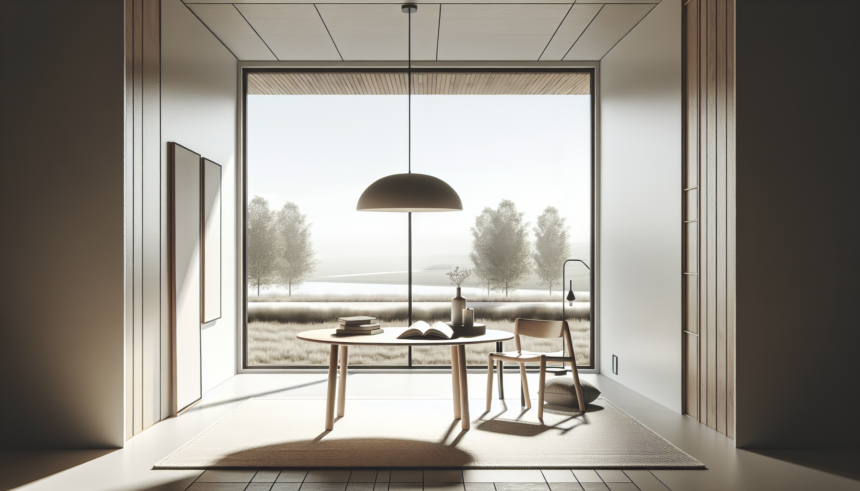<!DOCTYPE html>
<html lang="en">
<head>
<meta charset="UTF-8">
<meta name="viewport" content="width=device-width, initial-scale=1.0">
<title>Article on Minimalist Design</title>
<style>
body {
font-family: Arial, sans-serif;
line-height: 1.6;
margin: 20px;
}
header, section, footer {
margin-bottom: 20px;
}
h1, h2, h3 {
color: #333;
}
h1 {
font-size: 2em;
margin-bottom: 10px;
}
h2 {
font-size: 1.5em;
margin-bottom: 10px;
}
h3 {
font-size: 1.2em;
margin-bottom: 10px;
}
</style>
</head>
<body>
<header>
<h1>The Power of Minimalist Design: Simplicity at Its Best</h1>
</header>
<section>
<p>In the modern world, where our senses are constantly bombarded with stimuli from all angles, the appeal of minimalist design has never been greater. Minimalism, characterized by simplicity, clean lines, and a focus on functionality, offers a refreshing antidote to the cluttered, hyperactive landscapes that dominate much of contemporary life. This design philosophy is not about stripping away for the sake of deprivation but rather about creating an environment where each element serves a purpose and contributes to a harmonious whole. By focusing on what truly matters, minimalist design enhances usability and brings a sense of peace and clarity to our lives.</p>
</section>
<section>
<h2>The Essence of Minimalist Design</h2>
<p>Minimalist design thrives on the principle of "less is more." This concept involves paring down elements to their essential functions, eliminating unnecessary components, and creating an uncluttered, visually pleasing environment. Key features of minimalist design include ample white space, limited color palettes, and the use of simple geometric forms. Whether applied to architecture, interior design, graphic design, or web design, minimalism emphasizes clarity, efficiency, and elegance.</p>
</section>
<section>
<h2>Benefits of Minimalist Design</h2>
<h3>Improved Usability</h3>
<p>One of the significant benefits of minimalist design is improved usability. By prioritizing functionality and removing extraneous elements, minimalist design allows users to focus on what is truly important. This clarity reduces cognitive load and makes it easier for users to navigate and interact with products, whether it's a website, an app, or a physical space.</p>
<h3>Aesthetic Appeal</h3>
<p>Minimalist design is inherently aesthetically pleasing. The use of clean lines, balanced proportions, and a restrained color palette creates a sense of harmony and order. This visual simplicity is often associated with sophistication and elegance, making minimalist design a popular choice among those who value style and refinement.</p>
<h3>Focus on Quality</h3>
<p>When you remove excess, what remains must be of the highest quality. Minimalist design encourages a focus on craftsmanship and attention to detail. Whether it's a piece of furniture, a website interface, or a building, each component must be meticulously designed and executed to ensure it serves its purpose effectively and beautifully.</p>
<h3>Environmental and Financial Benefits</h3>
<p>Minimalist design can also offer practical benefits, such as reduced environmental impact and cost savings. By focusing on fewer, better-quality items, we can minimize waste and make more sustainable choices. Additionally, a minimalist approach to design often requires less material and fewer resources, which can reduce overall costs.</p>
</section>
<section>
<h2>Minimalist Design in Various Disciplines</h2>
<h3>Architecture and Interior Design</h3>
<p>In architecture and interior design, minimalism translates to open spaces, simple forms, and the use of natural light. Furniture and decor are kept to a minimum, with an emphasis on functional pieces that are both beautiful and practical. The result is a serene, uncluttered living environment that promotes relaxation and well-being.</p>
<h3>Graphic and Web Design</h3>
<p>In the digital world, minimalist design has become a hallmark of modern websites and apps. Clean layouts, ample white space, and a focus on essential content create a seamless and user-friendly experience. By removing unnecessary distractions, minimalist web design enhances readability and makes it easier for users to find the information they need.</p>
<h3>Product Design</h3>
<p>Product designers also embrace minimalism to create items that are both functional and visually appealing. From smartphones to kitchen appliances, minimalist products are characterized by their simple, elegant forms and intuitive use. This approach not only enhances the user experience but also ensures that the products blend seamlessly into a variety of environments.</p>
</section>
<section>
<h2>Challenges and Misconceptions</h2>
<p>Despite its many benefits, minimalist design is not without its challenges. One common misconception is that minimalism equates to blandness or lack of personality. However, minimalism's true aim is to strip away the unnecessary so that the essential can shine. It requires a keen eye and a disciplined approach to achieve the perfect balance between simplicity and interest.</p>
<p>Another challenge is that minimalist design demands careful consideration and planning. Because every element must serve a purpose, designers need to be meticulous in their choices and ensure that each aspect of the design contributes to the overall vision. This attention to detail can be time-consuming and may require a deeper level of expertise compared to more maximalist approaches.</p>
</section>
<section>
<h2>Conclusion</h2>
<p>Minimalist design is far more than an aesthetic trend; it is a philosophy that prioritizes functionality, clarity, and quality. In a world where we are constantly surrounded by noise and distractions, minimalism offers a way to create spaces and products that are both beautiful and practical. By embracing the power of simplicity, we can improve usability, enhance our environment, and foster a sense of calm and order in our lives. Whether applied to architecture, interior design, digital interfaces, or daily objects, minimalist design exemplifies the idea that less truly can be more.</p>
</section>
<footer>
<h2>Frequently Asked Questions</h2>
<h3>1. Is minimalist design only suitable for modern spaces?</h3>
<p>No, minimalist design can be adapted to a variety of styles and settings. While it is often associated with modern and contemporary spaces, the principles of simplicity and functionality can complement traditional and eclectic designs as well.</p>
<h3>2. How can I incorporate minimalist design into my home?</h3>
<p>Start by decluttering and removing unnecessary items. Focus on quality over quantity, and choose furniture and decor that are functional and aesthetically pleasing. Use a neutral color palette, and let natural light enhance the space.</p>
<h3>3. Can minimalist design be warm and inviting?</h3>
<p>Yes, minimalist design can be warm and inviting. Incorporating natural materials, such as wood and textiles, and using warm colors can create a cozy and welcoming atmosphere. The key is to balance simplicity with elements that add comfort and personality.</p>
<h3>4. Is minimalist design expensive?</h3>
<p>Minimalist design does not have to be expensive. While it emphasizes quality, it also encourages the use of fewer items. You can achieve a minimalist look by investing in key pieces and focusing on the essentials. Thrift stores and DIY projects can also provide budget-friendly options.</p>
<h3>5. Can minimalism work in family homes with children?</h3>
<p>Yes, minimalism can work in family homes. It can create a more organized and functional living space that is easier to maintain. Choose durable, multi-functional furniture and create designated storage areas to keep toys and belongings neatly arranged.</p>
</footer>
</body>
</html>









